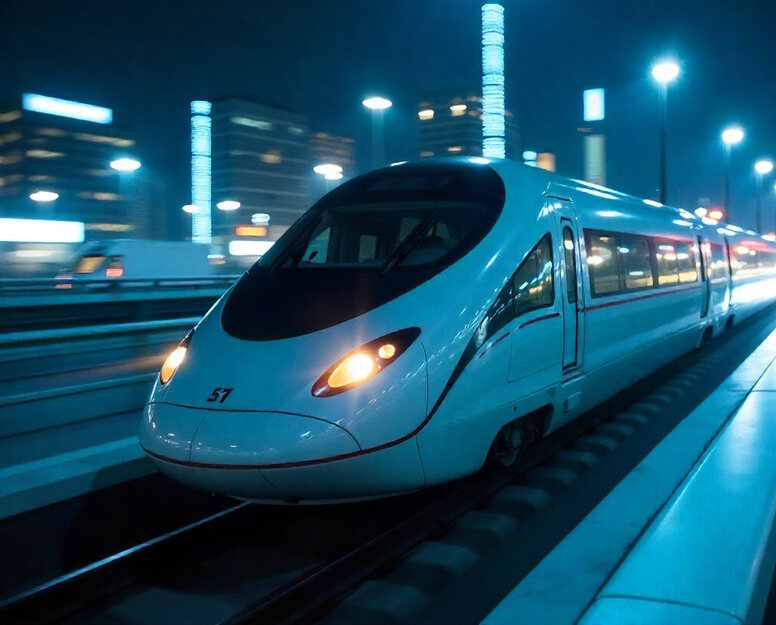Published on
October 6, 2025
Japan has unveiled a groundbreaking maglev train that will connect Tokyo and Nagoya in just forty minutes, thanks to the use of cutting-edge high-speed rail technology. This revolutionary train uses superconducting magnetic levitation (maglev) to eliminate friction between the train and tracks, allowing it to travel at speeds of up to 500 kilometers per hour. The result is a significant reduction in travel time compared to traditional rail systems. Not only does the maglev train offer faster travel, but it also provides a smoother, quieter ride, while minimizing environmental impact. With this groundbreaking innovation, Japan is set to redefine the future of high-speed rail travel, combining speed, sustainability, and comfort to meet the needs of modern passengers.
Revolutionizing Passenger Comfort with Thoughtful Design
One of the most striking features of the new maglev train is its focus on passenger experience, with an emphasis on both comfort and practicality. Unlike conventional high-speed trains that often include reclining seats for a more relaxed journey, the maglev train opts for non-reclining, fixed-angle seating. Positioned at a 15-degree angle, these seats are designed for short-distance travel, providing adequate comfort while maximizing space. This thoughtful design choice ensures that the cabin remains simple and efficient, with more room for passengers to stretch their legs and store their luggage.
The seating arrangement is also lighter and slimmer than traditional options, which brings multiple benefits. Not only does it reduce the overall weight of the train, but it also simplifies maintenance. Fewer parts mean lower maintenance costs, easier cleaning, and faster seat replacements. This minimalist design, which emphasizes efficiency and functionality, helps to lower operational costs and ensures a cleaner, more streamlined passenger environment.
The cabin also introduces a greater sense of openness, with more space between seats and a wider layout. The M10 prototype, unveiled earlier this year, exemplifies this design philosophy, featuring a modern, ergonomic interior with a more relaxed and spacious feel. These changes aim to provide passengers with a less confined travel experience, promoting ease of movement and enhancing comfort on the go. Once final adjustments and certifications are completed, the commercial version of the maglev train will be ready for public use, offering travelers a blend of speed and comfort never before seen in rail transport.
Blazing Speeds with a Green Footprint
At the heart of the maglev’s appeal is its impressive speed capability. The train is engineered to reach speeds of up to 500 kilometers per hour, drastically reducing travel time between Tokyo and Nagoya. This high-speed achievement is made possible by the innovative use of superconducting magnetic levitation, which eliminates the friction that typically slows down conventional trains. Without the need for wheels to touch the tracks, the train glides effortlessly, ensuring a smoother and quieter journey.
The lack of friction also contributes to the system’s energy efficiency. By reducing the need for constant energy output to overcome the drag of traditional rail wheels, the maglev train consumes less electricity, making it more environmentally friendly. Passengers can enjoy the speed and comfort of their journey knowing that the system has a smaller carbon footprint compared to traditional high-speed rail systems. Additionally, the quieter operation of the train means that noise pollution in surrounding areas is kept to a minimum, further enhancing the eco-friendly profile of the maglev network.
For even greater passenger well-being, the seats are ergonomically designed to distribute body weight evenly, preventing fatigue even on longer journeys. This design consideration ensures that passengers feel refreshed upon arrival, a significant advantage over traditional high-speed trains that often leave travelers feeling worn out after high-speed trips.
Challenges and Future Expansion Plans
While the maglev project has generated excitement, it has also encountered some setbacks. Originally slated for completion by 2027, the Tokyo-Nagoya section has faced delays due to construction challenges and disputes along the route. As a result, the anticipated opening has been pushed back, with officials now looking to launch the line in 2034 or later.
However, these delays have not diminished the long-term potential of the maglev system. Once completed, the train line will eventually extend to Osaka, further enhancing the efficiency of Japan’s transportation network. When finished, this expansion will form one of the most advanced and interconnected rail networks in the world, offering a modern solution to intercity travel.
Japan has unveiled a groundbreaking maglev train that will connect Tokyo and Nagoya in just forty minutes, utilizing advanced high-speed rail technology to achieve speeds of up to 500 kilometers per hour. This innovation promises faster travel, a smoother ride, and greater sustainability, reshaping the future of rail transport.
Despite the delays, Japan’s maglev train remains a symbol of future-focused innovation. Its combination of high-speed travel, environmental sustainability, and passenger comfort is poised to change the face of rail travel for years to come. As the project progresses and the full network is realized, Japan will solidify its position as a global leader in rail technology and set a new standard for the future of transportation.
